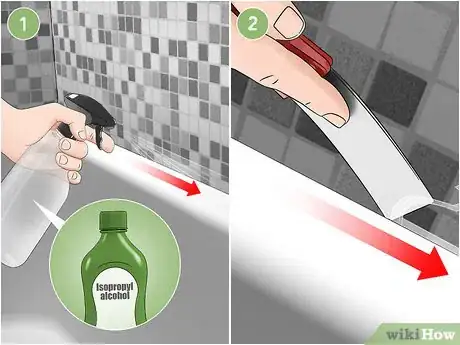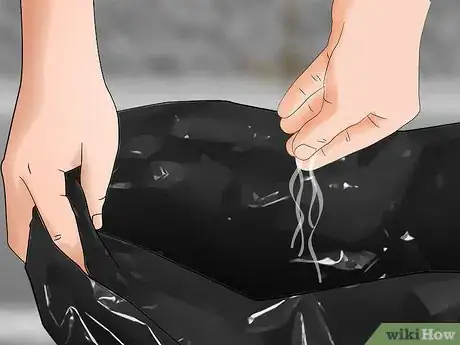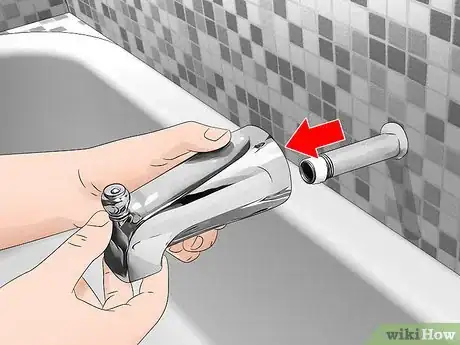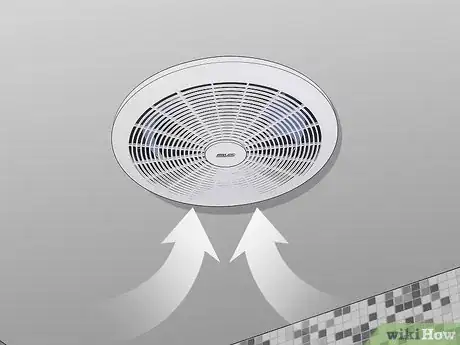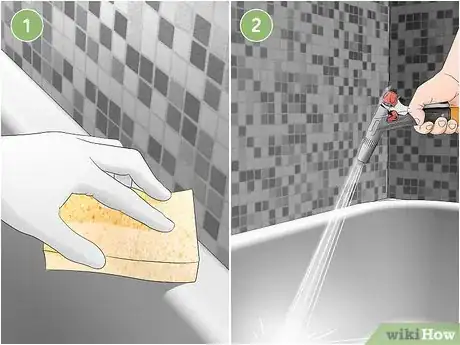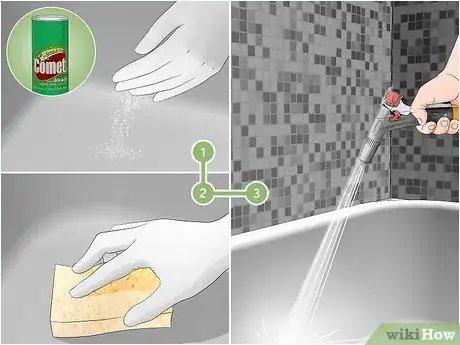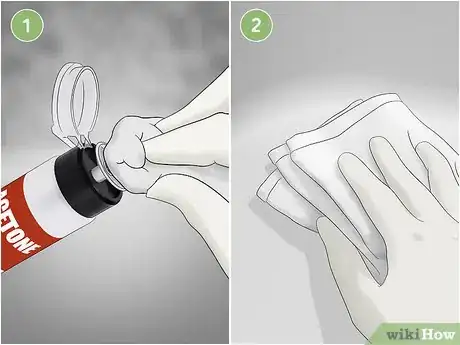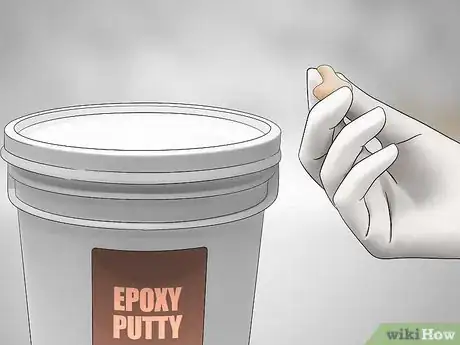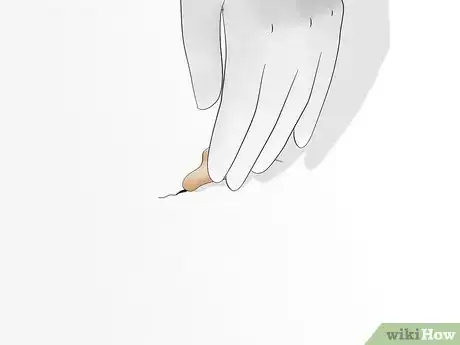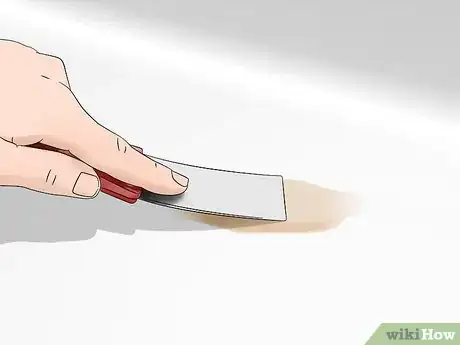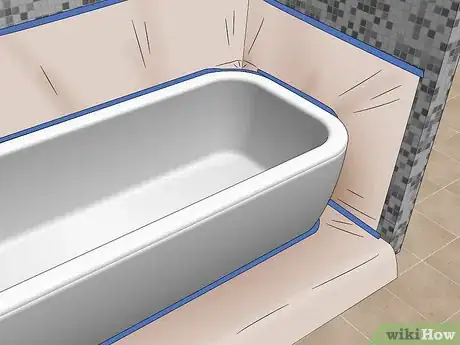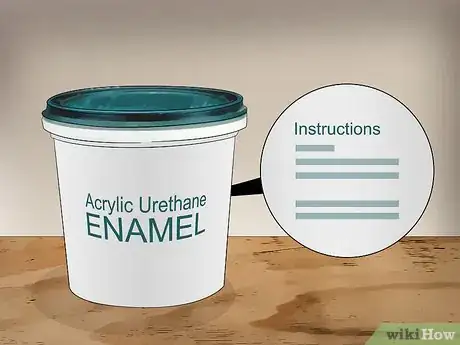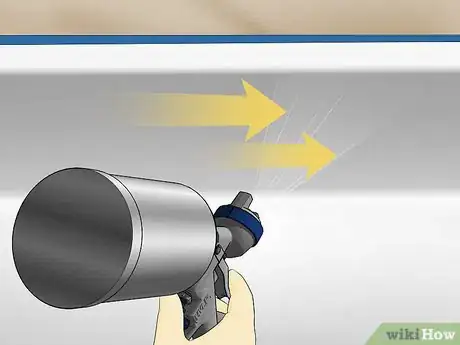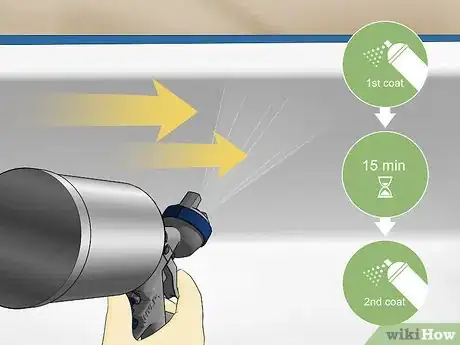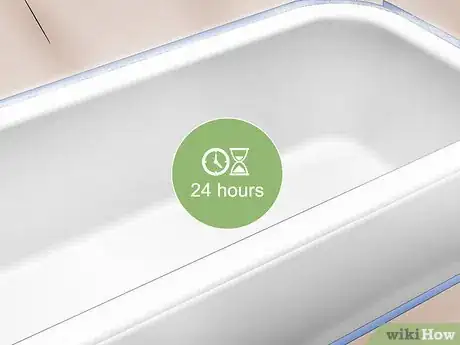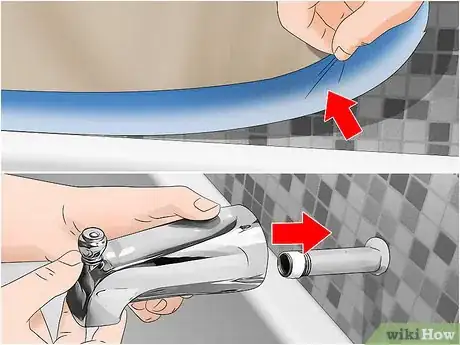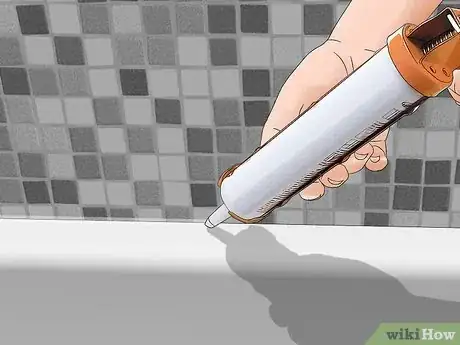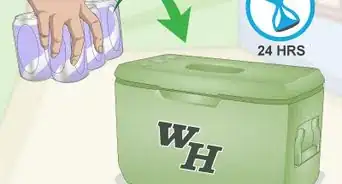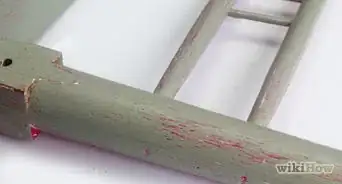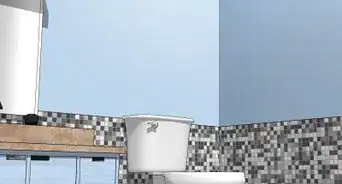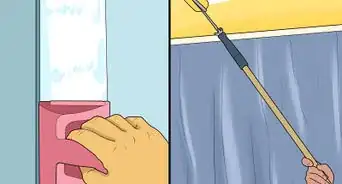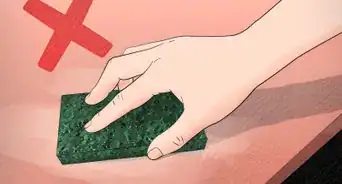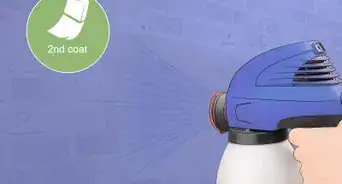This article was co-authored by Kevin Snow. Kevin Snow is a Commercial Painting Professional and the Owner of Ridge Painting Company. With over 12 years of experience, he specializes in painting commercial facilities and new build constructions. Kevin and his team are fully licensed and insured.
wikiHow marks an article as reader-approved once it receives enough positive feedback. In this case, 100% of readers who voted found the article helpful, earning it our reader-approved status.
This article has been viewed 333,612 times.
If your cast-iron tub is looking a little rundown, save some money and give it a new coat of paint rather than replacing it. After filling in any gaps or cracks, sanding down the interior and exterior, and giving it a few coats of acrylic urethane enamel paint, you’ll have a bathtub that looks brand new. It’ll cost you about $450 to refinish your tub yourself, versus over $3000 to replace it.[1]
Steps
Removing the Caulk
-
1Use a caulk-removing tool and isopropyl alcohol to clear away the caulk. Apply the isopropyl alcohol to the caulk via a spray bottle or blot it on with an old washcloth—this softens the caulk and makes it easier to remove. Use your caulk-removing tool to scrape away as much of the caulk as you can.[2]
- Wear rubber gloves while you work to protect your hands.
- You shouldn’t have to pay more than $10 for the caulk-removal tool.
-
2Discard of the old caulk so it doesn’t get in your way. Keep a garbage bag nearby as you scrape off the caulk so you can easily put it to the side. You won’t be able to reuse it for anything, so throw it away with your regular trash.[3]
- If you can’t get all of the caulk off, that’s okay—you’ll be sanding down the tub later and can work off any bits that are stuck then.
Advertisement -
3Remove the drain and the spout so they don't get painted. Use a screwdriver to take out the drain and water spout fixtures, then set them to the side. If you’re having trouble getting a part out, try lubing it with some oil to loosen the screws.[4]
- This is also a great time to give those fixtures a thorough cleaning. Submerge the fixtures in warm water and dish soap to loosen any hardened grime. Use an old toothbrush to scrub away any remaining dirt.
Bleaching the Bathtub
-
1Open windows or bring in a fan before you begin working with bleach. If your bathroom is small and doesn’t have a vent or windows, bring in a fan to blow air out as you work. The most important thing is that you’re getting fresh air so you aren’t just breathing in bleach fumes.[5]
- You can also wear a respirator if you’re concerned about the fumes.
-
2Wear rubber gloves and mix 90% water with 10% bleach. Use a large bucket to mix the water and bleach. Leave some room at the top of the bucket so that it doesn’t spill easily. Make sure to wear gloves and old clothes, too.[6]
- Fill up the bucket in the bathroom near the tub so you don’t have to try and transport it from another room.
-
3Scrub the tub with the bleach and water solution and then rinse it out. Use a sponge and start at one corner of the tub and systematically work your way around it. Squeeze out and re-soak your sponge as much as you need to. Rinse the tub out with fresh water after you’ve cleaned it. You can dump out the bleach/water mixture and fill that same bucket with clean water if you want to.[7]
- Don’t forget to scrub the exterior of the tub, too—you’re going to be painting the entire thing, so it all needs to be cleaned.
- Part of the painting process involves getting the tub as clean as possible beforehand so that the paint adheres to the surface better.[8]
-
4Wash the tub with an abrasive cleaner to ensure it’s clean. Use a product like Comet and sprinkle it over the entire surface of the tub. Use a new, wet sponge to scrub the tub. Rinse out your sponge periodically so it doesn’t get too gunky from the cleaner, and then rinse the tub again with fresh water.[9]
- If you don’t have Comet, you could sprinkle and scrub away baking soda for the same result.
-
5Use acetone on a clean washcloth to remove any residual cleaner. Dampen a clean washcloth with the acetone and wipe down the interior and exterior of the tub. Continue to wear your gloves—acetone can really dry out or hurt your skin if it comes into contact with it.[10]
- If there was any remaining cleaner, grease, or grime, the acetone will get rid of it.
Filling Gaps and Sanding the Tub
-
1Prepare the epoxy putty before applying it to any cracks. Wear rubber gloves to protect your skin, and read the manufacturer’s instructions before you begin. Open up the putty and tear or cut off a small section of the putty. Work the putty between your fingers until it is pliable, kind of like how you would massage a piece of play dough to work it into a new shape.[11]
- If you can’t find epoxy putty, buy a similar kind of tub-repair paste from your local hardware store.
-
2Fill any cracks or chips in your tub with the epoxy putty. Use your fingers to push putty into any chipped areas. Depending on how large the crack is, tear your putty pieces so the size is about right to just overfill the area. Make sure to push down on the putty firmly so that it makes its way into all the crevices.[12]
- At this stage, it’s okay if the putty isn’t flat with the rest of the tub’s surface.
-
3Use a putty knife to smooth over each of the patched areas. Take your putty knife and position the blade so it’s flat against the surface of the tub. Gently scrape it over the filled sections to remove any excess putty. Wipe off the blade from time to time with a damp paper towel.[13]
- If your working on a curved area, you may need to adjust your knife’s position a few times to get the entire area smooth.
-
4Sand the entire bathtub to work down the gloss and prepare it for paint. Use wet/dry sandpaper, and sand it with 400 grit sandpaper first, and then do it again with 600 grit sandpaper. Attach your sandpaper to a sanding block, and use a spray bottle to wet down the tub as you work.[14]
- The wet-sanding will eliminate a lot of dust, but it’s a good idea to keep wearing your respirator, especially if you’re working in a small space.
-
5Rinse out the tub and dry it completely before painting it. After the tub has been sanded, rinse out the interior and wipe down the exterior sides to remove any sandpaper and grit remnants. Use clean towels to dry it off thoroughly.[15]
- The tub needs to be 100% dry before you start painting it, so use as many towels as you need to.
Applying the Paint
-
1Tape protective sheets on the walls and floor. Before you paint, use masking or painters tape to secure plastic sheeting to the walls surrounding the tub, as well as to the floor underneath the tub. You may also want to lay plastic sheeting over any other fixtures, like the toilet or sink, and remove decorations, towels, and beauty products.[16]
- The paint you’re going to use is an acrylic spray paint, and the “dust” from it will settle on the walls and floors.
-
2Put on a respirator and wear old clothes once you’re ready to paint. Your clothes are going to get covered in paint dust, so wear things that you don’t mind getting dirty.[17] And use a respirator for safety purposes—the fumes from the paint will be really strong.[18]
- Remember to keep a window open or a fan running during the painting process.
-
3Follow the paint manufacturer’s instructions to prepare it properly. For a cast-iron or fiberglass tub, you can use acrylic urethane enamel, which may already come mixed for you, or you may have to mix it it, just depending on what kind of kit you purchased.[19]
- For fiberglass tubs, you can also use a two-part epoxy paint instead of the acrylic. The epoxy paint can be used on porcelain and ceramic tubs, too.[20]
- The easiest option for DIYing the paint job is to purchase kits that are designed specifically for that purpose. Some companies even provide spray cans of acrylic urethane enamel that you don’t have to mix at all.
-
4Load your spray gun and put the lid on the paint can. Follow the spray gun’s instructions for how much paint should be loaded into the body. Keep the lid on the paint can so that the enamel doesn’t start to dry up.[21]
- If you don’t want to use a spray gun, you could also use paint brushes and rollers. In that case, you wouldn’t need to load anything and could just mix the paint in its can to prepare.
-
5Coat the entire tub with long, even motions. Work systematically by starting at a top interior corner and working your way across the length of the tub. Keep the spray gun about 8 inches (20 cm) away from the tub. Repeat this process until the entire interior is painted, and then move on to the outside of the tub.[22]
- Spray painting is generally an easier process because you won’t have to lean over the tub and risk smearing the paint.
- Similarly, if you’re painting the tub by hand, use long, even strokes to coat the tub’s entirety.
-
6Let the first coat of paint dry and then apply a second one. It should take about 15-20 minutes for the first coat of paint to be dry to the touch. Once it is, go ahead and apply a second coat, working systemically as you go so you don’t miss any areas.[23]
- “Drying” and “curing” are two different things. Paint can be dry but not yet cured—the curing is when the paint dries and also hardens, and it generally takes a much longer time than just drying. Proceed with the second coat of paint once the first coat has simply dried.
Finishing the Tub
-
1Leave the tub alone until it has cured completely. Don’t step in it, run any water, or use it it any way. Follow the paint manufacturer’s instructions for the curing time, which is generally around 24 hours.[24]
- Some sites say you can also use a heat lamp to speed up the curing time, but that could also cause discoloration in the paint.
-
2Remove the masking tape and reattach the tub fixtures. Once the tub is dry, you can remove all the plastic sheeting and tape and replace the drain and faucet. Throw the sheeting and tape away.[25]
- You may also want to mop the floor and give the rest of the bathroom a thorough wipe-down to catch any dust or dirt left behind from the painting process.
-
3Re-caulk the tub before you use it again to protect it from mold. Use a caulking gun to reapply the caulk to the areas where the tub meets the shower, if that’s applicable. Follow the instructions for the brand you purchased and let it dry before you use the tub.[26]
- Caulk can take 24 hours to cure, but it’s generally safe to expose it to water after a few hours.
Expert Q&A
Did you know you can get expert answers for this article?
Unlock expert answers by supporting wikiHow
-
QuestionHow long will epoxy last?
 Kevin SnowKevin Snow is a Commercial Painting Professional and the Owner of Ridge Painting Company. With over 12 years of experience, he specializes in painting commercial facilities and new build constructions. Kevin and his team are fully licensed and insured.
Kevin SnowKevin Snow is a Commercial Painting Professional and the Owner of Ridge Painting Company. With over 12 years of experience, he specializes in painting commercial facilities and new build constructions. Kevin and his team are fully licensed and insured.
Commercial Painting Professional
-
QuestionCan I paint a moss green bathtub white?
 Community AnswerYes, but you will have to paint quite a few layers to cover the green.
Community AnswerYes, but you will have to paint quite a few layers to cover the green. -
QuestionWill the materials used to paint a tub be harmful to a septic tank?
 Sarah BattilanaCommunity AnswerYou generally shouldn't put any kind of paint down the drain if you have a septic tank. Instead, dispose of the paint by taking it to a recycling center.
Sarah BattilanaCommunity AnswerYou generally shouldn't put any kind of paint down the drain if you have a septic tank. Instead, dispose of the paint by taking it to a recycling center.
Things You’ll Need
- Caulk removal tool
- Isopropyl alcohol
- Screwdriver
- Bleach
- Cleaner
- Sponges
- Washcloths
- Acetone or paint thinner
- Quick-dry epoxy putty or similar product
- 400 and 600 grit wet sandpaper
- Spray bottle filled with water
- Sanding block
- Towels
- Masking tape
- Respirator
- Acrylic urethane enamel paint
- Paint buckets with lids
- Paint brushes and rollers (optional)
- Spray gun (optional)
- Caulking gun and caulk
References
- ↑ https://www.homeadvisor.com/cost/bathrooms/refinish-a-bathtub/
- ↑ https://youtu.be/hg2FfE7gpXM?t=37
- ↑ https://www.thisoldhouse.com/how-to/refinish-your-cast-iron-tub
- ↑ https://www.bobvila.com/articles/how-to-paint-a-bathtub/
- ↑ https://www.bobvila.com/articles/how-to-paint-a-bathtub/
- ↑ https://www.bobvila.com/articles/how-to-paint-a-bathtub/
- ↑ https://www.bobvila.com/articles/how-to-paint-a-bathtub/
- ↑ Kevin Snow. Commercial Painting Professional. Expert Interview. 23 March 2022.
- ↑ https://www.bobvila.com/articles/how-to-paint-a-bathtub/
- ↑ https://www.bobvila.com/articles/how-to-paint-a-bathtub/
- ↑ https://youtu.be/m97xugUCAQU?t=45
- ↑ https://www.bobvila.com/articles/how-to-paint-a-bathtub/
- ↑ https://www.bobvila.com/articles/how-to-paint-a-bathtub/
- ↑ https://www.bobvila.com/articles/how-to-paint-a-bathtub/
- ↑ https://www.bobvila.com/articles/how-to-paint-a-bathtub/
- ↑ https://www.homeadvisor.com/cost/bathrooms/refinish-a-bathtub/
- ↑ https://www.thisoldhouse.com/how-to/refinish-your-cast-iron-tub
- ↑ Kevin Snow. Commercial Painting Professional. Expert Interview. 23 March 2022.
- ↑ https://www.bobvila.com/articles/how-to-paint-a-bathtub/
- ↑ Kevin Snow. Commercial Painting Professional. Expert Interview. 23 March 2022.
- ↑ https://www.thisoldhouse.com/how-to/refinish-your-cast-iron-tub
- ↑ https://www.thisoldhouse.com/how-to/refinish-your-cast-iron-tub
- ↑ https://www.bobvila.com/articles/how-to-paint-a-bathtub/
- ↑ https://www.bobvila.com/articles/how-to-paint-a-bathtub/
- ↑ https://www.thisoldhouse.com/how-to/refinish-your-cast-iron-tub
- ↑ https://www.bobvila.com/articles/how-to-paint-a-bathtub/
- ↑ https://www.homeadvisor.com/cost/bathrooms/refinish-a-bathtub/
- ↑ https://www.homeadvisor.com/cost/bathrooms/refinish-a-bathtub/
- ↑ https://www.homeadvisor.com/cost/bathrooms/refinish-a-bathtub/
About This Article
To paint a bathtub, start by removing any old caulk using rubbing alcohol and a caulk-removal tool. Then, use bleach and an abrasive cleaner to thoroughly clean the tub so it's spotless when you paint it. Next, repair any damage with epoxy putty and sand the entire tub with 400-grit sandpaper followed by 600-grit sandpaper, which will wear down the gloss so the paint adheres to the tub. When you're finished, use a spray gun to apply 2 coats of acrylic urethane enamel, letting it dry in between coats. Finally, let the paint cure for 24 hours. To learn how to re-caulk a tub after you paint it, scroll down!
